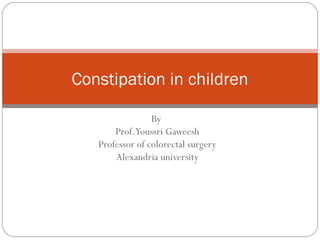This document provides information on constipation in children, including definitions, prevalence, types (functional vs organic), and management. Some key points:
- Functional constipation is more common than organic causes and typically starts after infancy. Chronic constipation accounts for 3-25% of pediatric GI visits.
- Idiopathic constipation is a self-perpetuating condition where untreated stool retention leads to dilated bowels and worsening constipation.
- Hirschsprung's disease is a rare cause of constipation characterized by absence of ganglion cells in parts of the bowel. Diagnosis involves biopsy and tests like barium enema.
- Slow transit constipation involves prolonged




















































































